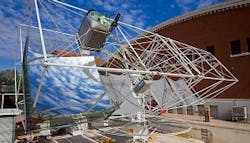REhnu concentrating solar technology funded, under construction at UA
Tucson, AZ--A 20 kilowatt concentrating photovoltaic system developed by University of Arizona (UA) astronomy and optics professor Roger Angel is quietly going up at the UA Science and Technology Park. The company created to commercialize the system, REhnu, has received $827,000 in investments to take its technology to the next level. Although there has been no formal announcement of the project, Angel said the installation should be up and running in the next few months.
"We're in a transition, out of the lab and into the realm of the commercial market," Angel said recently at the site of his latest prototype, undergoing tweaking and testing on the UA campus. Drawing heavily on the UA's optics and astronomy expertise, Angel's design uses mirrors to focus and concentrate sunlight up to 1200 times on a spherical lens, which transmits it onto an array of ultra-high-efficiency photovoltaic cells. The Solar Zone installation will start with one system of eight mirror arrays and collectors on a tracking mount. The 5-acre site has room for 42 individual systems, for a total output of 840 kilowatts.
Former UA President John P. Schaefer, who recently became CEO of REhnu, said the company plans to raise $1 million in investments this year and $25 million in coming years to build out the entire Solar Zone site and further develop the technology. Detailed in a Securities and Exchange Commission filing for REhnu Inc., 15 investors provided a total of $827,149 at the end of December in exchange for equity stakes in the company.
By 2020, REhnu is aiming for an installed cost of $1 per watt, at production volumes, and a levelized cost of energy production—including the capital and lifetime costs of an energy source—of 5 cents per kilowatt-hour, low enough for large-scale adoption without government subsidy. With the advanced concentrator technology, Angel said, he is working on getting the PV cell cost down to around 15 cents per watt. Together with mirrors and other hardware designed for ease of manufacture, the company should be able to meet the $1-per-installed-watt goal and perhaps spur local manufacturing as well, he said.
Borrowing from the sky-tracking mounts used for big telescopes, the REhnu system features a lightweight but rigid "spaceframe" built to withstand hurricane-force winds. The finely balanced, mass-produceable system quietly tracks the sun with a chain-driven, circular carriage powered by small electric motors. A relatively simple system of four water-cooled radiators arranged in a box keeps the receiving unit from overheating. The prototype is securely mounted in a 12-foot-deep hole filled with river rock, eliminating the cost of concrete.
SOURCE: Arizona Daily Star; http://azstarnet.com/business/local/f2de2026-8a40-55cb-8f03-5bf3e85a24ea.html

Gail Overton | Senior Editor (2004-2020)
Gail has more than 30 years of engineering, marketing, product management, and editorial experience in the photonics and optical communications industry. Before joining the staff at Laser Focus World in 2004, she held many product management and product marketing roles in the fiber-optics industry, most notably at Hughes (El Segundo, CA), GTE Labs (Waltham, MA), Corning (Corning, NY), Photon Kinetics (Beaverton, OR), and Newport Corporation (Irvine, CA). During her marketing career, Gail published articles in WDM Solutions and Sensors magazine and traveled internationally to conduct product and sales training. Gail received her BS degree in physics, with an emphasis in optics, from San Diego State University in San Diego, CA in May 1986.
